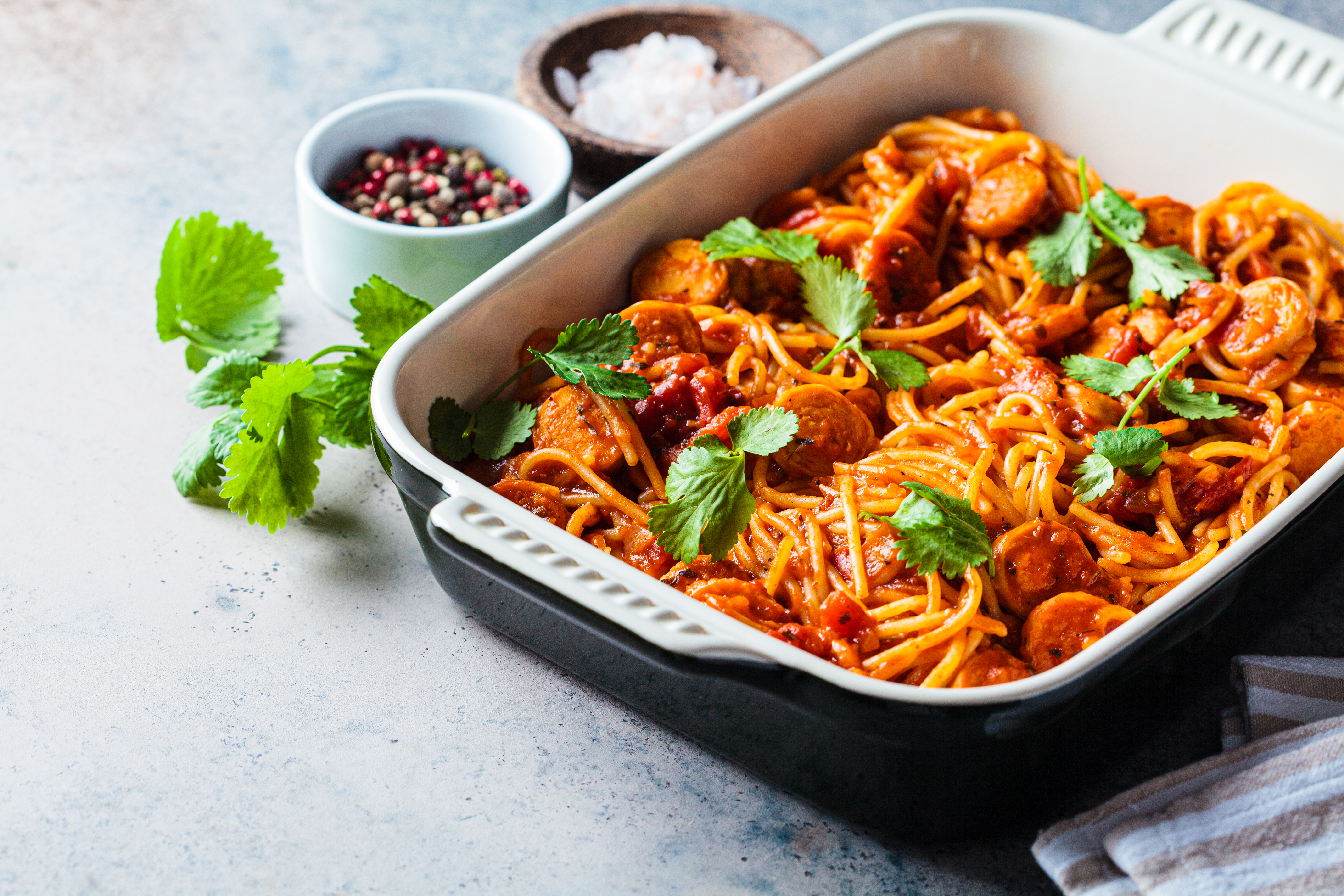Ingredients for this Baked Spaghetti Recipe
Baked spaghetti is a classic comfort food that is perfect for potlucks, family gatherings, or a weeknight dinner. This dish is easy to make and requires only a few ingredients. Here are the essential ingredients you will need to make baked spaghetti:
Spaghetti
Spaghetti is the star ingredient in this dish. You can use any type of spaghetti, but we recommend using thin spaghetti or vermicelli for the best results.
Cheese
Cheese is an essential ingredient in baked spaghetti. You will need both mozzarella cheese and parmesan cheese. The mozzarella cheese will give the dish its gooey, melted texture, while the parmesan cheese will add a nutty, salty flavor.
Sauce
A good sauce is key to making a delicious baked spaghetti. You can use any type of pasta sauce you like, but we recommend using a meat sauce or a tomato sauce with Italian seasoning for the best flavor.
Meat
Ground beef or Italian sausage is commonly used in baked spaghetti recipes. You can use either one or a combination of both to add flavor and protein to the dish.
Onion and Garlic
Onion and garlic are essential ingredients in any Italian dish. They add flavor and depth to the sauce.
Butter
Butter is used to give the dish a rich, buttery flavor. You can use unsalted butter or salted butter, depending on your preference.
Eggs
Eggs are used to bind the spaghetti together and give it a custardy texture.
Cottage Cheese
Cottage cheese is used to add creaminess to the dish. You can use either full-fat or low-fat cottage cheese.
Seasonings
Seasonings such as salt, black pepper, Italian seasoning, and red pepper flakes are used to add flavor to the dish.
Garnish
Fresh parsley or basil can be used to garnish the dish and add a pop of color.
Cooking Process
To start with the cooking process of the baked spaghetti recipe, you need to preheat the oven to 375°F. While the oven is heating up, bring a large pot of salted water to a boil. Add the spaghetti and cook until it is al dente, following the package instructions. Once cooked, drain the spaghetti and set it aside.
Next, take a baking dish and coat it with cooking spray. Transfer the cooked spaghetti to the baking dish and set it aside.
In a skillet, heat some olive oil over medium heat. Add chopped onions and sauté until translucent. Add sliced mushrooms and cook until they are fragrant. Then, add the marinara sauce and simmer for a few minutes until the sauce is heated through. If you prefer, you can also make a homemade sauce.
Once the sauce is ready, pour it over the spaghetti in the baking dish. Mix everything together until the spaghetti is coated with the sauce. Sprinkle some grated Parmesan cheese on top of the spaghetti.
Cover the baking dish with foil and bake in the preheated oven for about 25 minutes. Then, remove the foil and bake for another 10-15 minutes until the cheese is melted and bubbly.
Once done, remove the dish from the oven and let it cool for a few minutes before serving. You can also refrigerate the leftovers for later consumption.
Overall, the process of making easy baked spaghetti casserole is simple and straightforward, and it can be customized to suit your preferences. With this recipe, you can have a delicious and comforting meal in no time.
Nutritional Facts
When it comes to baked spaghetti, it’s important to pay attention to the nutritional facts. Here’s a breakdown of the key nutritional information for a typical serving of baked spaghetti:
- Calories: A serving of baked spaghetti contains around 325 calories, which is a moderate amount for a meal.
- Protein: You’ll get around 21% of your daily recommended protein from a serving of baked spaghetti.
- Fat: A serving of baked spaghetti contains around 16g of fat, which is about 21% of your daily recommended intake.
- Saturated Fat: You’ll get around 7.4g of saturated fat from a serving of baked spaghetti, which is about 37% of your daily recommended intake.
- Sodium: A serving of baked spaghetti contains around 709mg of sodium, which is about 31% of your daily recommended intake.
- Fiber: You’ll get around 2.9g of dietary fiber from a serving of baked spaghetti, which is about 10% of your daily recommended intake.
- Sugar: A serving of baked spaghetti contains around 4.4g of sugar, which is a moderate amount.
- Carbohydrates: A serving of baked spaghetti contains around 23g of carbohydrates, which is a moderate amount.
- Cholesterol: You’ll get around 62mg of cholesterol from a serving of baked spaghetti, which is about 21% of your daily recommended intake.
Overall, baked spaghetti can be a good source of protein and fiber, but it’s important to watch your intake of saturated fat and sodium. Additionally, if you’re watching your calorie intake, be mindful of portion sizes.
Additional Tips and Tricks
Now that you have the basic recipe for baked spaghetti, here are some additional tips and tricks to help you make the most out of your dish:
- Leftovers: Baked spaghetti is a great dish to make ahead of time and have as leftovers. Simply store the leftovers in an airtight container in the fridge for up to 3-4 days. When you’re ready to eat, simply reheat in the microwave or oven until heated through.
- Squares: If you want to serve your baked spaghetti in squares, let it cool in the pan for at least 10-15 minutes before cutting it into squares. This will help it hold its shape better.
- Aluminum foil: When baking your spaghetti, cover the top with aluminum foil for the first 20-25 minutes of baking. This will help prevent the cheese from burning and the spaghetti from drying out.
- Microwave: If you need to reheat your baked spaghetti quickly, simply place a serving on a microwave-safe plate and heat for 2-3 minutes on high. Stir the spaghetti halfway through to ensure even heating.
- 25 minutes: Keep an eye on your spaghetti while it’s baking. Depending on your oven, it may take slightly longer or shorter than the recommended 25 minutes. Check it at the 20-minute mark and adjust the baking time accordingly.
By following these tips and tricks, you can ensure that your baked spaghetti turns out delicious and perfect every time.
Suggested Pairings
Baked spaghetti is a hearty and comforting dish that can be served as a standalone meal or paired with complementary side dishes. Here are some suggestions to elevate your baked spaghetti experience:
- Caesar Salad: A classic Caesar salad is a great side dish to serve with baked spaghetti. The crisp romaine lettuce, creamy dressing, and crunchy croutons provide a refreshing contrast to the rich and savory flavors of the spaghetti. You can also add some shaved Parmesan cheese to the salad for an extra cheesy touch.
- Brussels Sprouts: Roasted Brussels sprouts are a perfect accompaniment to baked spaghetti. The nutty and slightly sweet flavor of the sprouts pairs well with the tomato sauce and cheese. You can roast the sprouts with some olive oil, salt, and pepper for a simple and delicious side dish.
- Vegetables: A side of steamed or roasted vegetables is a healthy and colorful addition to your baked spaghetti meal. You can choose from a variety of vegetables such as broccoli, carrots, asparagus, or green beans. Season the vegetables with some garlic, lemon juice, and herbs for extra flavor.
- Stuffed Shells: If you want to serve a pasta dish alongside your baked spaghetti, stuffed shells are a great option. The creamy ricotta filling and tomato sauce of the shells complement the flavors of the baked spaghetti. You can also sprinkle some mozzarella cheese on top of the shells for a cheesy twist.
- Zucchini: Zucchini is a versatile vegetable that can be used in many ways, including as a side dish for baked spaghetti. You can slice the zucchini into rounds or strips and sauté them with some garlic and olive oil. The zucchini will add a fresh and healthy element to your meal.
In summary, baked spaghetti can be paired with a variety of side dishes to create a well-rounded and satisfying meal. Whether you choose a classic Caesar salad, roasted Brussels sprouts, steamed vegetables, stuffed shells, or sautéed zucchini, your baked spaghetti meal is sure to be a hit.
Frequently Asked Questions
What are some variations of baked spaghetti recipes?
There are many variations of baked spaghetti recipes. Some people prefer to use ground beef or turkey, while others prefer vegetarian options. You can also add different types of cheese, such as mozzarella or Parmesan, to give your dish a unique flavor. Some recipes call for adding vegetables like mushrooms, onions, or bell peppers. You can also experiment with different sauces, such as marinara or Alfredo, to create a dish that suits your taste.
How do you prevent baked spaghetti from drying out?
To prevent baked spaghetti from drying out, cover it with aluminum foil while it’s cooking. This will help keep the moisture in and prevent the pasta from becoming too dry. You can also add a little bit of water or broth to the dish before baking to help keep it moist. Another option is to add a layer of cheese on top of the pasta, which will help keep it from drying out.
What are the ingredients in a typical baked spaghetti recipe?
A typical baked spaghetti recipe includes spaghetti noodles, a tomato-based sauce, ground beef or turkey, garlic, onion, and cheese. Some recipes also call for eggs, breadcrumbs, or cream cheese to help bind the dish together. You can also add additional vegetables or spices to enhance the flavor.
Can you eat baked spaghetti after 5 days?
It is not recommended to eat baked spaghetti after 5 days. Leftovers should be stored in an airtight container in the refrigerator and consumed within 3-4 days. If you are planning to store the dish for longer than 4 days, it is best to freeze it. Baked spaghetti can be frozen for up to 3 months.
What is the difference between baked spaghetti and regular spaghetti?
The main difference between baked spaghetti and regular spaghetti is that baked spaghetti is cooked in the oven. Baked spaghetti is typically made with a tomato-based sauce and ground beef or turkey, while regular spaghetti can be served with a variety of sauces. Baked spaghetti is also typically topped with cheese and sometimes breadcrumbs, while regular spaghetti is typically served with Parmesan cheese.
How do you make a creamy baked spaghetti?
To make a creamy baked spaghetti, you can add cream cheese or heavy cream to the dish. Simply mix the cream cheese or heavy cream with the tomato-based sauce before adding it to the pasta. You can also add additional cheese, such as ricotta or mozzarella, to give the dish a creamy texture. Another option is to use Alfredo sauce instead of tomato-based sauce.

